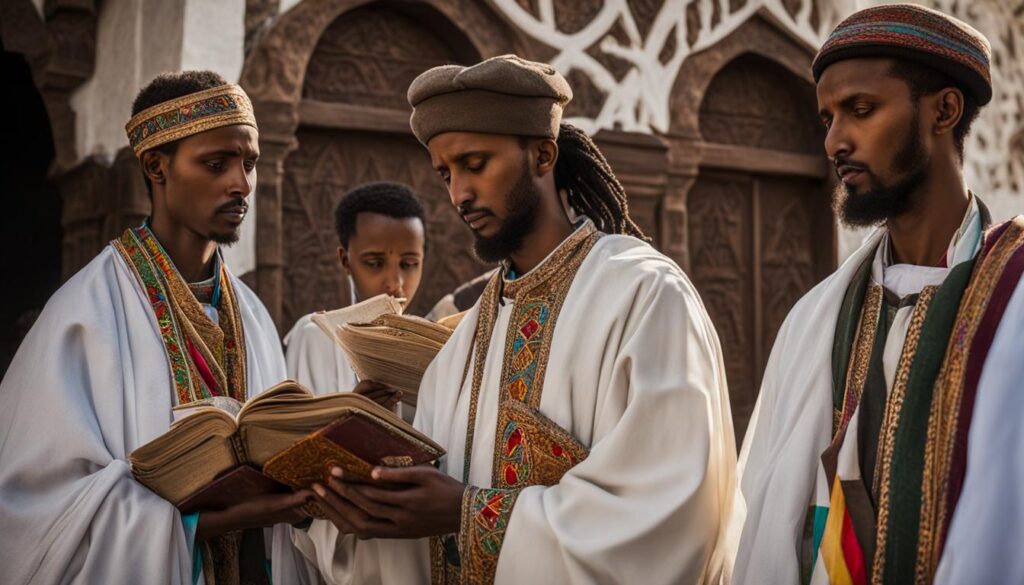Is Jesus From Ethiopia?
Did you know that there is a theory suggesting that Jesus, the central figure of Christianity, has connections to Ethiopia? While biblical sources state that Jesus was born in Bethlehem of Judah, a surprising historical perspective points to a potential Ethiopian origin. Let’s explore the fascinating theories and historical evidence surrounding Jesus and Ethiopia.
Key Takeaways:
- There is a theory proposing that Jesus may have Ethiopian origins.
- Historical evidence suggests a connection between Jesus and the tribe of Judah, which was an African tribe.
- Jesus and his family sought refuge among the black Egyptians, indicating an African connection.
The Oldest Branch of Christianity in Ethiopia
Ethiopian Christianity has a rich and ancient history, dating back to the fourth century. It is one of the oldest branches of Christianity in the world, with deep roots in the country’s cultural and religious fabric.
The Ethiopian Orthodox Tewahedo Church holds a significant place in Ethiopian Christian traditions. It is the largest and oldest Christian church in Ethiopia, playing a central role in the spiritual lives of millions of Ethiopians.
Due to its historical isolation from other Christian countries, the Ethiopian Orthodox Church developed its own unique traditions and practices, preserving ancient Christian customs and beliefs.
An example of this unique tradition is the Ethiopian Orthodox Church’s adherence to a 13-month calendar, which is seven to eight years behind the Gregorian calendar followed by most of the world. The church also has its own liturgical language, Ge’ez, and an intricate system of rituals and ceremonies.
“The Ethiopian Orthodox Tewahedo Church has been a stronghold of Ethiopian Christian spirituality for centuries, keeping alive the ancient Christian traditions and preserving a strong connection to the roots of the faith.”
Even in modern times, Ethiopian Christianity remains a vibrant and living religious tradition, deeply intertwined with daily life, culture, and identity. The church plays a vital role in education, healthcare, and community development throughout the country.
The Ethiopian Orthodox Tewahedo Church: Unique Features
Here are some distinctive features of the Ethiopian Orthodox Tewahedo Church:
- Highly ornate and beautifully decorated churches, often adorned with colorful paintings and religious icons.
- The Ark of the Covenant, believed by Ethiopian tradition to be housed in the Church of Our Lady Mary of Zion in Aksum.
- The Debre Damo monastery, an ancient monastic community situated on a mountain, accessible only by climbing a rope.
- The Ethiopian Christian liturgy, which combines beautiful chants, music, and religious rituals.
The Ethiopian Orthodox Tewahedo Church has played a significant role in shaping the religious and cultural landscape of Ethiopia. Its ancient traditions continue to inspire and guide millions of Ethiopian Christians in their spiritual journey.
| Key Features of Ethiopian Christianity | Description |
|---|---|
| Connection to ancient Christianity | Ethiopian Christianity dates back to the fourth century, making it one of the oldest branches of Christianity in the world. |
| Unique traditions and practices | The Ethiopian Orthodox Tewahedo Church developed its own distinct customs due to historical isolation, preserving ancient Christian rituals. |
| Integration of Ethiopian culture | Ethiopian Christianity has seamlessly blended with local customs, art, and music, creating a vibrant and enriching religious experience. |
| Strong influence on daily life | Ethiopian Christianity plays a central role in education, healthcare, community development, and social cohesion. |
The Origins of Ethiopian Christianity
Ethiopian Christianity can be traced back to the rule of King Ezana of Aksum in the fourth century. It was during this time that a Phoenician Christian named Frumentius arrived in Ethiopia and became a slave to the ruling family. Frumentius later had the opportunity to teach the young prince Ezana about the Christian faith, ultimately leading to the conversion of the entire kingdom to Christianity. This marked the beginning of the spread of Christianity throughout Ethiopia, with the establishment of Christian churches and monastic communities.
Ethiopia’s embrace of Christianity under King Ezana and the influence of Frumentius contributed to the flourishing of the faith in the region. The establishment of Christian institutions paved the way for the growth and development of Ethiopian Christianity, which continues to be a prominent religious tradition in Ethiopia today.
To better understand the historical significance of this pivotal moment in Ethiopian history, let’s delve deeper into the lives of King Ezana and Frumentius.
King Ezana of Aksum
King Ezana, also known as Ezana the Great, ruled the ancient kingdom of Aksum from approximately 325 to 360 AD. During his reign, he made Christianity the official religion of Aksum, thereby bringing about a profound religious and cultural transformation.
Under King Ezana’s patronage, the construction of monumental churches and the preservation of religious artifacts became a priority. This royal support contributed to the spread of Ethiopian Christianity and solidified its place in the hearts and minds of the Ethiopian people.
Frumentius: The Apostle of Ethiopia
Frumentius, or Abba Salama, as he is known in Ethiopia, played a crucial role in the Christianization of Aksum. As a slave, he used his position to advocate for the Christian faith, ultimately demonstrating its values and teachings to King Ezana.
“The king asked us what things we had.” We said, “We have a God who loves mankind and has given His Son to systematize our entire constitution according to certain principles… We eat [and] drink just for our own sustenance; wives are allowed for each man, but only one.”[1]
Convinced by Frumentius’s teachings, King Ezana embraced Christianity and propagated its tenets throughout his kingdom. Frumentius was later consecrated as the first Ethiopian bishop, cementing his position as a key figure in Ethiopian Christian history.
The Spread of Christianity in Ethiopia
The conversion of King Ezana and the royal court to Christianity had a profound impact on the Ethiopian people. Christianity began to flourish, and the faith spread rapidly as churches and monastic communities were established across the kingdom.
The Ethiopian Orthodox Tewahedo Church, which originated during this period, developed its own distinct traditions and practices. Ethiopian Christianity blended elements of Judaism, ancient Egyptian religious traditions, and Hellenistic influences, resulting in a unique form of worship and religious expression.
This early phase of Ethiopian Christianity laid the foundation for the future growth and enduring presence of the faith in Ethiopia. The teachings of Jesus Christ, as interpreted and practiced by Ethiopian Christians, have played a central role in shaping the cultural, social, and spiritual fabric of the country.
| Key Figures | Key Events |
|---|---|
| King Ezana of Aksum | Declares Christianity the official religion of Aksum. |
| Frumentius | Teaches Christianity to King Ezana and the royal court. |
| Establishment of Christian Churches | Christianity spreads throughout Ethiopia with the establishment of churches and monastic communities. |
Table: The Origins of Ethiopian Christianity
Ethiopian Christianity and Oriental Orthodoxy
The Ethiopian Orthodox Tewahedo Church, along with the Coptic Church of Egypt and other churches in Asia, is a part of Oriental Orthodoxy. This branch of Christianity diverged from the rest of the Christian community following the Council of Chalcedon in 451.
The Council formulated the Chalcedonian Confession, which proclaimed that Jesus had two distinct natures – divine and human. However, the Ethiopian and Coptic Churches held to the belief of miaphysitism, which posits that Jesus had a single nature that was both divine and human.
These differences in theology and understanding of the nature of Jesus led to the separation between Oriental Orthodoxy and other Christian traditions. Despite this divergence, Ethiopian Christianity remains deeply rooted in the Oriental Orthodox tradition.
“The Ethiopian Orthodox Tewahedo Church embraces the miaphysite perspective, emphasizing the unity of Christ’s nature as both fully God and fully human.”
Comparison of Oriental Orthodoxy and Other Christian Traditions
| Oriental Orthodoxy | Other Christian Traditions |
|---|---|
| Belief in miaphysitism, the unity of Christ’s nature | Belief in the Chalcedonian Confession, the duality of Christ’s nature |
| Ethiopian Orthodox Tewahedo Church | Various denominations, such as Roman Catholicism and Protestantism |
| Coptic Church of Egypt | Roman Catholic Church and various Protestant denominations |
Despite the doctrinal differences, Oriental Orthodoxy and other Christian traditions share a common foundation in their reverence for Jesus Christ as the Son of God and their commitment to spreading the message of His teachings.
As we explore the origins and practices of Ethiopian Christianity, it becomes evident that its connection to Oriental Orthodoxy plays a significant role in shaping its unique identity and religious practices.
The Connection between Ethiopian Christianity and the Solomonic Dynasty

The Solomonic dynasty in Ethiopia claims a direct descent from King Solomon and the Queen of Sheba, as described in the Kebra Nagast, an Ethiopian epic. According to tradition, the Queen of Sheba visited King Solomon in Jerusalem and conceived a child, Menelik I, who later became the first emperor of Ethiopia. The Kebra Nagast also states that Menelik brought the Ark of the Covenant from Jerusalem to Ethiopia, which is believed to be housed in the Church of Our Lady Mary of Zion in Aksum.
“The Solomonic dynasty in Ethiopia claimed direct descent from King Solomon and the Queen of Sheba.”
The tale of the Queen of Sheba and King Solomon is enshrined in the Kebra Nagast, a revered Ethiopian text, which connects the Ethiopian monarchy to the biblical lineage of King David and therefore, ultimately, to Jesus Christ. This fascinating narrative has been a cornerstone of Ethiopian national identity, reinforcing the sense of divine authority and historical continuity of the Ethiopian rulers.
| Key Figures | Description |
|---|---|
| King Solomon | Biblical figure renowned for his wisdom and wealth, as well as his role in the construction of the First Temple in Jerusalem. |
| Queen of Sheba | Ancient ruling Queen of an unidentified kingdom in the region of present-day Ethiopia and Yemen, who visited King Solomon seeking wisdom and knowledge. |
| Menelik I | According to Ethiopian legend, the son of King Solomon and the Queen of Sheba, who is said to have become the first emperor of Ethiopia. |
| Ark of the Covenant | According to Ethiopian tradition, the sacred relic containing the tablets of the Ten Commandments brought from Jerusalem to Ethiopia by Menelik I. |
Unique Forms of Ethiopian Christian Art
Ethiopian Christianity has a rich tradition of art that encompasses various forms, from iconic paintings to illuminated manuscripts and processional crosses. These artistic expressions hold deep religious and cultural significance within the Ethiopian Orthodox Tewahedo Church.
Ethiopian Christian Icons
One of the most distinctive features of Ethiopian Christian art is the depiction of biblical figures in icons. These icons often portray saints, angels, and scenes from the life of Jesus with large, almond-shaped eyes and a two-dimensional appearance. The unique style of Ethiopian Christian icons reflects the country’s rich artistic heritage and spiritual beliefs.
Illuminated Manuscripts
Another remarkable form of Ethiopian Christian art is the creation of illuminated manuscripts. These meticulously crafted manuscripts blend intricate calligraphy, vibrant colors, and ornamental designs to bring to life the sacred texts of the Bible. Ethiopian illuminated manuscripts are renowned for their beauty and attention to detail, serving as important religious artifacts.
Processional Crosses
Processional crosses are extensively used in Ethiopian Orthodox Church ceremonies and processions. These crosses, often made of metal or wood, are adorned with intricate carvings, colorful enamel, and precious gemstones. Each processional cross is a unique piece of art, representing the devotion and reverence of the Ethiopian Christian community.
“Ethiopian Christian art is a testament to the profound spirituality and creativity of the Ethiopian Orthodox Tewahedo Church.”
Ethiopian Christian art often portrays significant religious themes and narratives, such as the birth of Jesus, the Virgin Mary, and the angels. Additionally, the story of Saint George, the patron saint of Ethiopia, is a popular subject depicted in Ethiopian Christian art.
| Forms of Ethiopian Christian Art | Description |
|---|---|
| Ethiopian Christian Icons | Biblical figures depicted with almond-shaped eyes and two-dimensional appearance. |
| Illuminated Manuscripts | Sacred texts of the Bible adorned with intricate calligraphy and vibrant colors. |
| Processional Crosses | Ornate crosses used in church ceremonies, embellished with carvings and gemstones. |
The artistic expressions of Ethiopian Christianity not only serve as objects of devotion but also reflect the cultural heritage and deep-rooted faith of the Ethiopian people.
Emphasis on Fasting in Ethiopian Christianity

Ethiopian Christianity places a strong emphasis on fasting compared to other Christian denominations. The Ethiopian Orthodox Church’s fasting schedule follows a conservative interpretation of Biblical teachings, with ordinary believers fasting for 180 days a year and priests and monks fasting for 250 days.
Two significant fasting periods in Ethiopian Christianity are the Nativity Fast and the Lenten fasting period. The Nativity Fast occurs 40 days before Orthodox Christmas, and the Lenten fasting period lasts for 55 days. Both of these fasting periods are among the longest in the Ethiopian calendar.
The Nativity Fast is observed in preparation for the celebration of the birth of Jesus Christ, and it is a time of reflection, prayer, and abstinence. During this period, believers abstain from meat, dairy products, and certain types of oil.
The Lenten fasting period is a solemn time leading up to Easter, commemorating the passion, death, and resurrection of Jesus Christ. During this period, believers also abstain from meat and dairy products, as well as certain grains and legumes.
These fasting practices serve as a spiritual discipline and a means of purifying the body and mind. Fasting in Ethiopian Christianity is seen as a way to connect with God, strengthen faith, and experience divine grace.
| Fasting Period | Duration | Requirements |
|---|---|---|
| Nativity Fast | 40 days | Abstain from meat, dairy products, and certain oils. |
| Lenten fasting period | 55 days | Abstain from meat, dairy products, certain grains, and legumes. |
Similarities and Differences in Ethiopian Christianity
Ethiopian Christianity, with its rich cultural heritage, exhibits both similarities and differences when compared to Judaism and Islam. This unique blend of influences is a result of the historical connections between Ethiopian Christianity and the Jewish and Muslim communities in Ethiopia.
One notable similarity between Ethiopian Christianity and Judaism is the prohibition on eating pork. Just as in Jewish religious practices, Ethiopian Christians refrain from consuming pork as part of their dietary customs. Additionally, both traditions place importance on the ritualistic slaughter of animals, following specific guidelines and practices.
On the other hand, Ethiopian Christian customs also share similarities with Islam. For instance, male circumcision is a prevalent ritual in Ethiopian Christianity, mirroring the practice found in Islam. Gender segregation in places of worship is another common feature shared by Ethiopian Christianity and Islam.
These shared practices highlight the interconnectedness of religious traditions and the cultural exchange that has shaped Ethiopian Christianity over centuries.
“Ethiopian Christianity showcases the beauty of diversity and the ability of different faiths to coexist, fostering a rich and unique religious tapestry.”
In summary, Ethiopian Christianity preserves its own distinct customs and practices, while also bearing resemblances to both Judaism and Islam. This fusion of influences has shaped a vibrant and diverse religious tradition in Ethiopia.
| Ethiopian Christianity | Judaism | Islam |
|---|---|---|
| Prohibition on eating pork | Prohibition on eating pork | |
| Emphasis on ritualistic animal slaughter | Emphasis on ritualistic animal slaughter | |
| Male circumcision | Male circumcision | |
| Gender segregation in churches | Gender segregation in mosques |
Role of Ethiopian Christianity in Environmental Conservation

Ethiopian Christianity has the potential to play a significant role in environmental conservation efforts. While scientific solutions are crucial for addressing climate change, religion can also contribute to the sociocultural aspects of tackling this pressing issue. The teachings and practices of the Ethiopian Orthodox Church align with principles of environmental conservation, emphasizing the stewardship of God’s creation.
Integrating religious values with environmental awareness can lead to positive changes in society, promoting sustainable practices and fostering a sense of responsibility towards the natural world. The teachings of Ethiopian Christianity emphasize the importance of simplicity, moderation, and respect for all living beings, which are fundamental principles in environmental conservation.
“The earth is the Lord’s, and everything in it, the world, and all who live in it.” – Psalm 24:1
By embracing these teachings and applying them to everyday life, followers of Ethiopian Christianity can contribute to the preservation of the environment and the mitigation of climate change. The practice of fasting, a significant aspect of Ethiopian Christianity, can also be seen as an act of environmental conservation. Fasting promotes simplicity, reduces consumption, and raises awareness of the impact of our choices on the natural world.
In addition to individual actions, Ethiopian Christianity has the power to mobilize communities and advocate for environmental conservation on a larger scale. The church can serve as a platform for education, raising awareness about the importance of sustainable practices and encouraging collective action. By promoting environmental conservation as an integral part of their religious beliefs, Ethiopian Christians can inspire others to join the cause and make a positive impact on the planet.
The Call for Action: Christianity and Climate Change
Climate change is a global challenge that requires collective efforts from people of all faiths and backgrounds. Christianity, with its vast influence and reach, has the potential to be a powerful force in addressing climate change and promoting environmental conservation. The teachings and values of Christianity, including love, stewardship, and caring for God’s creation, provide a strong foundation for environmental activism and sustainability.
As Christians, we have a responsibility to protect and preserve the natural world for future generations. By integrating environmental consciousness into our faith, we can inspire meaningful action and contribute to the global movement towards a more sustainable future. Let us come together as believers and stewards of the Earth, working towards a harmonious coexistence with nature and striving for a better world for all.
Let us be guided by the words of Pope Francis in his encyclical Laudato Si’:
“All of us can cooperate as instruments of God for the care of creation, each according to his or her own culture, experience, involvements and talents.” – Pope Francis
Together, we can make a difference and build a greener, more sustainable future for our planet. Let our faith inspire us to take action, to be mindful of our environmental impact, and to stand as advocates for the protection and conservation of God’s magnificent creation.
Christianity in Ethiopia Today
In Ethiopia, Christianity remains the dominant religion, with the Ethiopian Orthodox Tewahedo Church boasting the largest number of followers. However, there has been significant growth in Protestant denominations, particularly the Ethiopian Evangelical Church Mekane Yesus, which now has millions of members. Catholicism also has a presence in Ethiopia, with over half a million believers.
Christianity plays a vital role in the cultural and spiritual life of Ethiopians. The diverse Christian communities in the country contribute to the rich religious landscape, encompassing various traditions and practices.
As the current state of Ethiopian Christianity demonstrates, there is a dynamic and evolving religious landscape in the country. The growth of Protestant denominations offers alternative expressions of faith, attracting a significant following. This expansion represents a diversification of religious practices and beliefs, providing Ethiopian Christians with more choices and avenues for worship.
Our commitment to highlighting the growth of Protestantism in Ethiopia reflects our mission to provide a comprehensive understanding of the current state of Ethiopian Christianity. By exploring its diverse expressions and traditions, we gain insights into the unique spiritual tapestry of Ethiopia.
Conclusion
Throughout history, Ethiopian Christianity has played a significant role in shaping the cultural and religious fabric of Ethiopia. The origins of Jesus and the connections to Ethiopia continue to inspire debates and interpretations, highlighting the ongoing relevance and fascination surrounding this topic. With its unique traditions, the Ethiopian Orthodox Tewahedo Church has remained a vibrant and influential religious institution, fostering a sense of community and spirituality among its followers.
Ethiopian Christianity stands out for its emphasis on fasting, with believers and clergy adhering to rigorous fasting schedules throughout the year. This dedication to self-discipline and spiritual devotion further underscores the significance of faith in the lives of Ethiopian Christians. Additionally, the rich artistic expressions found in Ethiopian Christian art, including iconic paintings and illuminated manuscripts, reflect the deep spiritual connection and devotion to biblical narratives.
Furthermore, Ethiopian Christianity showcases a strong commitment to environmental conservation. The teachings of the Ethiopian Orthodox Church emphasize stewardship of God’s creation, aligning with efforts to address climate change and preserve the natural world. By integrating religious values with environmental awareness, Ethiopian Christianity has the potential to contribute to positive changes and promote sustainability.
In conclusion, Ethiopian Christianity’s rich history, unique practices, and enduring influence make it a crucial component of Ethiopian society. Its impact on culture, art, and environmental awareness highlights its relevance, serving as a testament to the dynamic and profound nature of this ancient Christian tradition.




